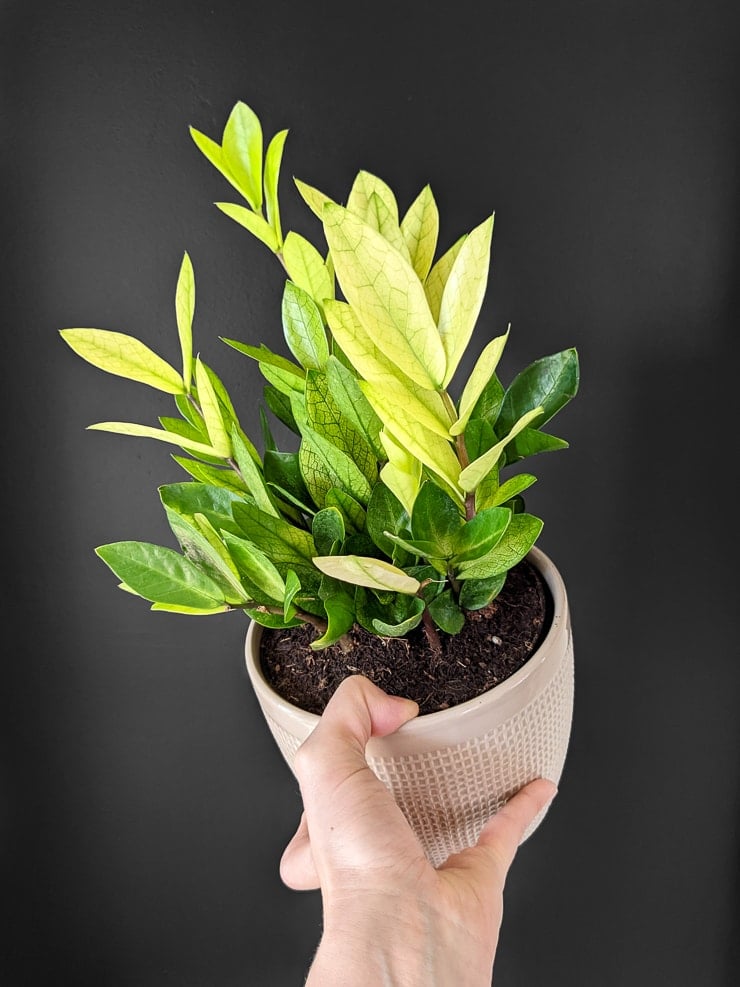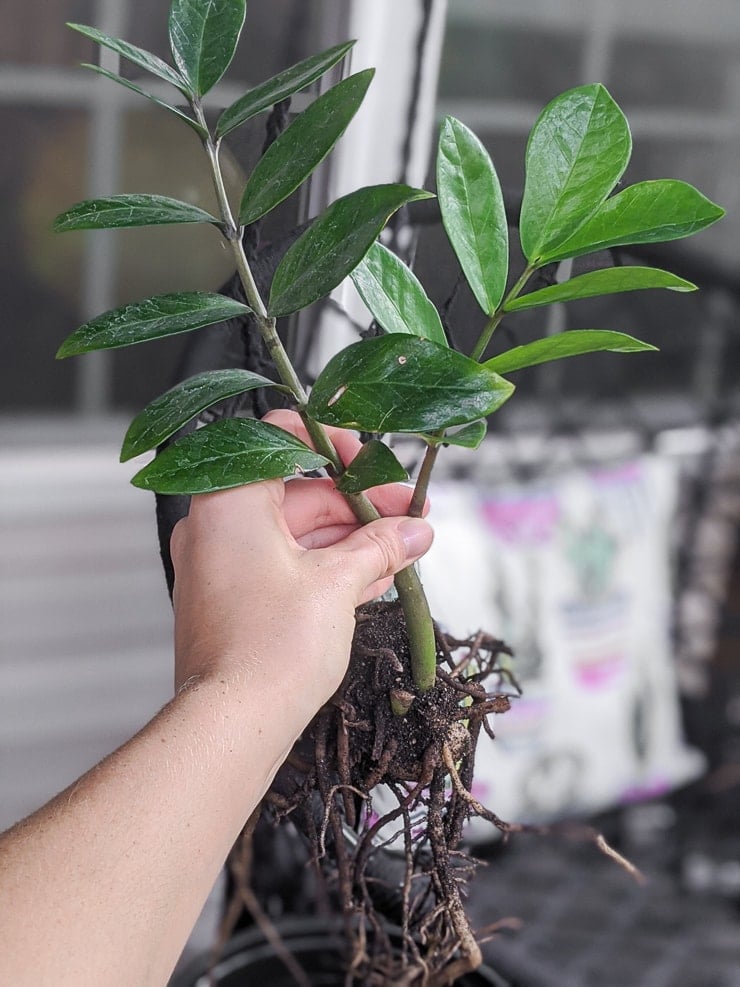Today’s post is all about the ZZ chameleon plant, a cool new variety of the hardy all-green zamioculcas zamiifolia (ZZ) plant that changes colors as it grows! Learn what makes this plant special, as well as if it is variegated or not.
ZZ chameleon plant care
Whenever I hear someone say that they aren’t good with houseplants but want to become good with houseplants, there are a few starter plants I suggest. Snake plants and ZZ plants are the two most common. (See my post with different snake plant varieties I’ve owned, too!)
Because these plants truly are made of steel! Do you forget to water your plants, letting them wither away and die slowly? ZZ plant has you covered. I love a good low maintenance house with flexible lighting requirements, so I was really excited to see this new variety of zamioculcas zamiifolia—or ZZ plant—hit the market.


What is a ZZ chameleon plant?
ZZ chameleon is a new type of ZZ plant derived from the classic all-green ZZ plant. Much like the raven ZZ plant that was rolled out widely a few years ago, the chameleon is a welcome addition to the ZZ lineup. (Read my raven ZZ care guide as well.)
While the raven ZZ’s leaves emerge lime green and eventually harden off to a nearly pure black, the ZZ chameleon’s leaves emerge an almost highlighter yellow with green veining and harden off to green.
This means that at any given time, the chameleon has a lovely mix of yellow and green. This gives it a distinct look from the all-green ZZ plant despite the fact that the foliage does eventually turn about the same shade of green.


Where was the ZZ chameleon discovered?
Chameleon is patented (see the full patent here) and was discovered by Michael Kerry Rimland in November 2017 at a plant nursery in Bangkok, Thailand. The spontaneous mutation was then selectively reproduced using cuttings in early 2018, ultimately showing that the mutation was stable and able to be replicated in new plants.
The large plant grower Costa Farms is now producing the plant en masse, so you’ll likely begin seeing it pop up here and there. It’s part of their Trending Tropicals collection, and they’re currently producing it exclusively.

Is the ZZ chameleon the same as a variegated ZZ plant?
While the ZZ chameleon’s patent information does use the word “variegated” to describe the plant, it is not a true variegated ZZ plant. While some of the ZZ chameleon’s leaves have variegation in them, that variegation is accompanied by pure yellow and pure green leaves.
And the variegation is metachromatic, meaning it will change in color from yellow to variegated green and yellow to green—the final color. Once the leaves are green, they will no longer change colors.
This is compared to another variegated variety of the ZZ plant—Zamioculcas zamiifolia “LUCKYWHIT,” or the lucky white ZZ plant (USPP23614P2). Lucky white’s leaves remain variegated and do not morph from light to dark over their life.
Below is a type of variegated ZZ plant for comparison. This plant was not labeled, only identified as a “variegated ZZ plant.” You’ll also notice that the prices on true variegated ZZ plants are very high—likely in the hundreds. Chameleon is a nice alternative 🙂

Does ZZ chameleon like sun or shade?
I often hear ZZ plants referred to as low-light plants. While the all-green variety of the ZZ plant does tolerate lower light levels quite well, it slows down the growth a lot. As for the ZZ chameleon variety, medium to bright indirect light is best.
The good news is that you can keep this plant relatively far from a window—it should just be in a room that has some sort of constant natural light or grow light supplement. There’s no need to put it in your sunniest spot, but keep in mind that it will grow best in brighter conditions.
Avoid direct sunlight, especially outdoors. It will burn the leaves. Put it on a covered patio or under a shade cloth if you move the plant outdoors for the summer—or if you’re lucky enough to live somewhere that stays warm year round.


Water & soil needs
ZZ plants are all-stars when it comes to drought tolerance. I recommend planting all ZZ plants in a succulent or succulent-like mix to help with water and oxygen flow. (Learn how to make your own succulent soil as well.)
ZZ plants grow from rhizomes underneath the soil line (they sometimes peep above the soil line, too). You’ll hear these rhizomes referred to as “bulbs” or “tubers” as well. They look like potatoes!
When I was very new to plants many years ago, I got a ZZ plant from Ikea. Once it needed to be repotted, I was startled and freaked out by the rhizomes! I had no idea what they were, and it looked like something was wrong.
But the ZZ plant’s potato-like rhizome structures play a critical role in the plant’s survival. Not only do new stems sprout from the rhizomes, but the rhizomes retain water. These water reserves are what help the plant go long periods of time without new water.
Because the ZZ plant stores water in the rhizomes, I recommend watering your ZZ chameleon plant only when the soil has dried out completely. Honestly, I have gone weeks without watering my big raven ZZ plant, and it continues to throw out new growth.
Overwatering will likely lead to root and rhizome rot, which will kill the plant. Keep an eye on your plant if you suspect overwatering—it can rebound by letting the soil dry out completely and trim rotted areas off, repotting with fresh soil.


Growth rate & ZZ chameleon size
ZZ plants are generally slow growers. My plants will throw out a new stem every few months during the spring and summer. I have had my raven ZZ plant for several years, and it’s quite large now. It started off about the size of the chameleon pictured throughout this post.
At its largest, expect the ZZ chameleon variety to reach about 4 feet tall or more. But that will take ideal growing conditions and a very long time. You’ll probably need to repot your ZZ chameleon only every few years.
To be honest, it has been about 3 years since I last repotted my raven ZZ! And I also have it in a pot without drainage holes. (I know, boo, hiss, bad me.) But it’s happy and I just make sure to keep an even lighter hand when watering it.


Temperature & humidity
ZZ chameleon tolerates all normal household temperatures and humidity levels well. It is not particularly needy when it comes to humidity, so no need to add a humidifier. However, if it’s near a humidifier, it’s no biggie. It will be fine.
Make sure to keep your ZZ chameleon in temperatures of 60, 70, or 80 degrees Fahrenheit for best growth. It is notcold or frost hardy, but in my experience, ZZ plants can tolerate temperatures that dip down into the 40s at night here and there.
It’s best not to make this a habit, though. Mine shipped to me without a heat pack and experienced a very unseasonably cold night on its way to me. It was totally fine.


How toxic is a ZZ plant to pets?
All parts of ZZ plants are toxic if ingested. While it’s fine to be around the plant and to touch its foliage, it can lead to pain, burning sensation, and swelling if ingested. Keep away from nibbling kids or pets.
The plant’s sap can also be irritating to some people, so I always recommend wearing protective gloves when pruning or repotting the plant.
How to propagate a ZZ plant
ZZ chameleon is a patented variety, so propagation of this plant is prohibited. However, If you have a plant you’d like to split for your own personal use, it’s easy to separate ZZ plants at the rhizome level and pot them up separately.


Pin my ZZ chameleon care guide!


Brittany is a seasoned DIY home and garden expert, running a creative brand since 2014 that inspires others with approachable plant care guides, woodworking tutorials, and decor projects. She is a certified project manager and has completed extensive coursework in the art and science of growing your own plants. Her work has been recognized by major publications, and she routinely collaborates with fellow DIY industry leaders—but her favorite thing to do is inspire you! Learn more about her here.

My Chameleno ZZ plant is growing very well but the leaves don’t turn gold yellow look as it should be. Please give me some advices. Thank you
Hi! I’ve found it can take quite a while and plenty of bright indirect light.